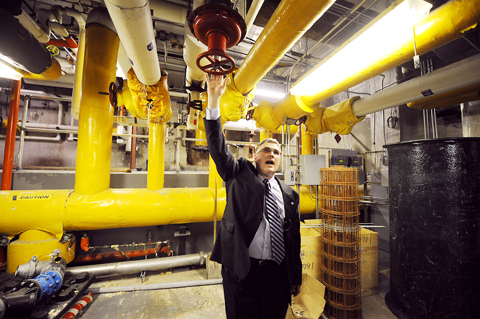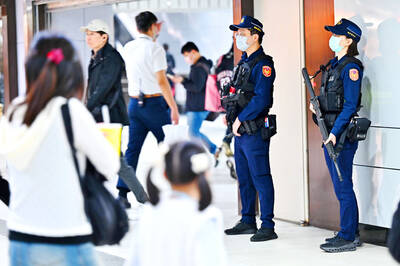Changing windows in New York sounds easy — but changing the planet too? That’s the goal at the Empire State Building, where switching windows, all 6,500, is part of a retrofit meant to transform the tower — the scene of King Kong’s last stand in the Hollywood classic — into an eco-friendly model for the world.
Anthony Malkin, representing the owners, said the multimillion-dollar project — a massive upgrade of heating, cooling and lighting systems — will reduce energy consumption by 38 percent.
Commercial buildings produce 78 percent of greenhouse emissions in New York, so greening the Empire State Building is a big step.

PHOTO: AFP
And the idea is that if you can do that in a 1931 Art Deco skyscraper, you can do it anywhere.
“It has a real rippling effect beyond this building and this city,” said Kathy Baczko at the Clinton Climate Initiative, part of former US president Bill Clinton’s foundation, which is backing the project. “It’s a new beacon for how you can be energy efficient.”
The retrofit adds US$20 million to the US$500 million cost of a general refurbishment underway at the iconic tower.
According to planners, full efficiency gains will kick in by 2013, bringing annual savings of US$4.4 million and placing the skyscraper in the top 10 percent of office buildings for greenness.
Malkin, president of Wien and Malkin, which oversees the building for the owners, including the Malkin family, likes stressing business friendly aspects, including the potential to attract higher-paying tenants.
TREE HUGGER
He talked passionately about preventing global warming from turning the world to “toast,” but bristled during an interview at being seen as a tree hugger.
“It’s not about greening,” said Malkin, 46, whose office carpet, shirt and even tie all happened to be various shades of green. “This is sound business. That’s what this is about.”
What makes the project new, organizers say, is a holistic approach that seeks causes of problems — for example variation in office temperature — as well as solutions.
“People have looked at specific technologies, the lighting, or the heating, but not at the building as a whole,” said Paul Rode, a project executive with the engineering company Johnson Controls.
This analysis took 18 months, in which 65 areas were modeled and eight were chosen as targets for the retrofit, ranging from better insulated windows to occupancy sensors for lights.
The Empire State Building is most famous for being tall, a soaring, tapering stack of 102 floors ending with a multi-colored, illuminated spire.
But Rode says the remake starts underground in the cavernous and wasteful chiller plant, which he describes as “a time warp.”
“Everything you see,” he said, pointing to a wall covered with archaic-looking control dials and red lamps, “is going into that” — a single desktop, flat-screen computer.
That software, as well as hardware like new motors and compressors, will bring sophistication to a system currently churning out heat and cold with little regard to actual demand.
INNOVATION
Up on the 62nd floor, looking down on the toy-like Manhattan and Hudson River, Rode explained how new windows will complement that newly intelligent system.
“The first thing we noticed was that 6,500 windows provided a lot of light, but also heat,” he said.
The current windows are double-glazed. Each will be removed and given a third film, with layers of argon/krypton gas and microscopic aluminum to provide insulation and repel ultra-violet sun rays.
“We want to let in the visible light, but not the heat-producing, non-visible rays,” Rode said.
A former nuclear engineer on navy ships, Rode said he was initially unexcited by the idea of working on an office building.
But the tower presents “very novel complexities” that have captured his imagination.
One of them is performing this top-to-bottom rejuvenation without changing the appearance of the historic building — or getting in the way of 10,500 tenants and almost 4 million annual tourists.
“It’s like changing the black-and-white TV into a color TV, but have it look exactly the same — except for the picture — and all while people are still watching,” he said.
GAME OVER
Surveying the Empire State Building from the terrace at his nearby office, Malkin said the elegant skyscraper was “a big lab, a big test bench” for reducing the carbon footprint of older office buildings everywhere.
“Every single thing was done with the understanding that it has to be part of a replicable process,” Malkin said.
And if the world ignores that challenge?
“Then it’s game over,” Malkin said.

A car bomb killed a senior Russian general in southern Moscow yesterday morning, the latest high-profile army figure to be blown up in a blast that came just hours after Russian and Ukrainian delegates held separate talks in Miami on a plan to end the war. Kyiv has not commented on the incident, but Russian investigators said they were probing whether the blast was “linked” to “Ukrainian special forces.” The attack was similar to other assassinations of generals and pro-war figures that have either been claimed, or are widely believed to have been orchestrated, by Ukraine. Russian Lieutenant General Fanil Sarvarov, 56, head

SAFETY FIRST: Double the number of police were deployed at the Taipei Marathon, while other cities released plans to bolster public event safety Authorities across Taiwan have stepped up security measures ahead of Christmas and New Year events, following a knife and smoke bomb attack in Taipei on Friday that left four people dead and 11 injured. In a bid to prevent potential copycat incidents, police deployments have been expanded for large gatherings, transport hubs, and other crowded public spaces, according to official statements from police and city authorities. Taipei Mayor Chiang Wan-an (蔣萬安) said the city has “comprehensively raised security readiness” in crowded areas, increased police deployments with armed officers, and intensified patrols during weekends and nighttime hours. For large-scale events, security checkpoints and explosives

PUBLIC SAFETY: The premier said that security would be tightened in transport hubs, while President Lai commended the public for their bravery The government is to deploy more police, including rapid response units, in crowded public areas to ensure a swift response to any threats, President William Lai (賴清德) said yesterday after a knife attack killed three people and injured 11 in Taipei the previous day. Lai made the remarks following a briefing by the National Police Agency on the progress of the investigation, saying that the attack underscored the importance of cooperation in public security between the central and local governments. The attack unfolded in the early evening on Friday around Taipei Main Station’s M7 exit and later near the Taipei MRT’s Zhongshan

REBUFFED: In response to Chinese criticism over recent arms sales, Washington urged Beijing to engage in meaningful dialogue instead of threats and intimidation Washington’s long-term commitment to Taiwan would not change, the US Department of State said yesterday, urging Beijing to stop pressuring Taiwan and engage in meaningful bilateral dialogues. The remarks came in response to a backlash from Beijing about Washington’s latest approval of arms sales to Taiwan. The US Defense Security Cooperation Agency said in a statement on Wednesday that the Taipei Economic and Cultural Representative Office in the US has asked to purchase an arms package, including Tactical Mission Network Software; AH-1W helicopter spare and repair parts; M109A7 self-propelled howitzers; HIMARS long range precision strike systems; tube-launched, optically tracked, wire-guided missiles; Javelin